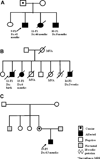Clinicopathologic comparison of familial versus sporadic atypical teratoid/rhabdoid tumors (AT/RT) of the central nervous system
- PMID: 20848638
- PMCID: PMC3210729
- DOI: 10.1002/pbc.22757
Clinicopathologic comparison of familial versus sporadic atypical teratoid/rhabdoid tumors (AT/RT) of the central nervous system
Abstract
Background: Central nervous system (CNS) atypical teratoid/rhabdoid tumors (AT/RT) are aggressive tumors usually diagnosed in young children and characterized by SMARCB1 (INI1, hSNF5) gene abnormalities. Despite initial chemo-radiation responsiveness, most children die of progressive disease (PD). Little data regarding familial AT/RT clinical course exist. This study described and compared familial (F) versus sporadic (S) AT/RT and elucidated SMARCB1 mutations and inheritance patterns.
Methods: A retrospective chart review, pedigree, and SMARCB1 analysis were done.
Results: Between January 1989 and June 2009, 20 children with CNS AT/RT were diagnosed, 8-S and 12-F. Median age at diagnosis (months) of S and F patient were: 13 and 4.8, respectively. Median survival (months) was S-21, F4.5, and 8-all. Pedigree analyses showed unaffected parent carriers with multiple affected offspring.
Conclusions: Children with F-AT/RT are younger, have more extensive disease, and are more likely to die from PD than children with S-AT/RT. Surgery, radiation, and chemotherapy were important in achieving long-term survival. Pedigree analysis supports autosomal dominant inheritance pattern with incomplete penetrance. Germline SMARCB1 mutation analysis is important in all patients diagnosed with AT/RT to (1) determine actual incidence of F-AT/RT, (2) determine penetrance of predisposing mutations, (3) provide appropriate genetic counseling, and (4) establish surveillance screening guidelines.
Copyright © 2010 Wiley-Liss, Inc.
Conflict of interest statement
Conflict of interest: Nothing to declare.
Figures
Similar articles
-
Predisposition to atypical teratoid/rhabdoid tumor due to an inherited INI1 mutation.Pediatr Blood Cancer. 2006 Sep;47(3):279-84. doi: 10.1002/pbc.20622. Pediatr Blood Cancer. 2006. PMID: 16261613
-
Germline INI1 mutation in a patient with a central nervous system atypical teratoid tumor and renal rhabdoid tumor.Genes Chromosomes Cancer. 2000 May;28(1):31-7. doi: 10.1002/(sici)1098-2264(200005)28:1<31::aid-gcc4>3.0.co;2-y. Genes Chromosomes Cancer. 2000. PMID: 10738300
-
[Atypical teratoid/rhabdoid tumors of childhood].Arkh Patol. 2013 Sep-Oct;75(5):36-42. Arkh Patol. 2013. PMID: 24341231 Russian.
-
Atypical teratoid/rhabdoid tumors and choroid plexus tumors: when genetics "surprise" pathology.Brain Pathol. 2003 Jul;13(3):409-14. doi: 10.1111/j.1750-3639.2003.tb00039.x. Brain Pathol. 2003. PMID: 12946029 Free PMC article. Review.
-
Atypical teratoid/rhabdoid tumors of the central nervous system.J Neurooncol. 2005 Dec;75(3):309-13. doi: 10.1007/s11060-005-6762-8. J Neurooncol. 2005. PMID: 16195799 Review.
Cited by
-
Relevance of Molecular Groups in Children with Newly Diagnosed Atypical Teratoid Rhabdoid Tumor: Results from Prospective St. Jude Multi-institutional Trials.Clin Cancer Res. 2021 May 15;27(10):2879-2889. doi: 10.1158/1078-0432.CCR-20-4731. Epub 2021 Mar 18. Clin Cancer Res. 2021. PMID: 33737307 Free PMC article. Clinical Trial.
-
Educational paper: screening in cancer predisposition syndromes: guidelines for the general pediatrician.Eur J Pediatr. 2011 Mar;170(3):285-94. doi: 10.1007/s00431-010-1377-2. Epub 2011 Jan 6. Eur J Pediatr. 2011. PMID: 21210147 Free PMC article. Review.
-
High expression of BMP pathway genes distinguishes a subset of atypical teratoid/rhabdoid tumors associated with shorter survival.Neuro Oncol. 2011 Dec;13(12):1296-307. doi: 10.1093/neuonc/nor140. Epub 2011 Sep 23. Neuro Oncol. 2011. PMID: 21946044 Free PMC article.
-
Germline variants in SMARCB1 and other members of the BAF chromatin-remodeling complex across human disease entities: a meta-analysis.Eur J Hum Genet. 2018 Aug;26(8):1083-1093. doi: 10.1038/s41431-018-0143-1. Epub 2018 Apr 30. Eur J Hum Genet. 2018. PMID: 29706634 Free PMC article. Review.
-
Case report: long-term survival of an infant syndromic patient affected by atypical teratoid-rhabdoid tumor.BMC Cancer. 2013 Mar 5;13:100. doi: 10.1186/1471-2407-13-100. BMC Cancer. 2013. PMID: 23510391 Free PMC article.
References
-
- Rorke LB, Packer RJ, Biegel JA. Central nervous system atypical teratoid/rhabdoid tumors of infancy and childhood: Definition of an entity. J Neurosurg. 1996;85:56–65. - PubMed
-
- Biegel JA, Rorke LB, Emanuel BS. Monosomy 22 in rhabdoid or atypical teratoid tumors of the brain. N Engl J Med. 1989;321:906. - PubMed
-
- Rorke LB, Packer R, Biegel J. Central nervous system atypical teratoid/rhabdoid tumors of infancy and childhood. J Neurooncol. 1995;24:21–28. - PubMed
-
- Packer RJ, Biegel JA, Blaney S, et al. Atypical teratoid/rhabdoid tumor of the central nervous system: Report on workshop. J Pediatr Hematol Oncol. 2002;24:337–342. - PubMed
-
- Olson TA, Bayar E, Kosnik E, et al. Successful treatment of disseminated central nervous system malignant rhabdoid tumor. J Pediatr Hematol Oncol. 1995;17:71–75. - PubMed
Publication types
MeSH terms
Substances
Grants and funding
LinkOut - more resources
Full Text Sources


